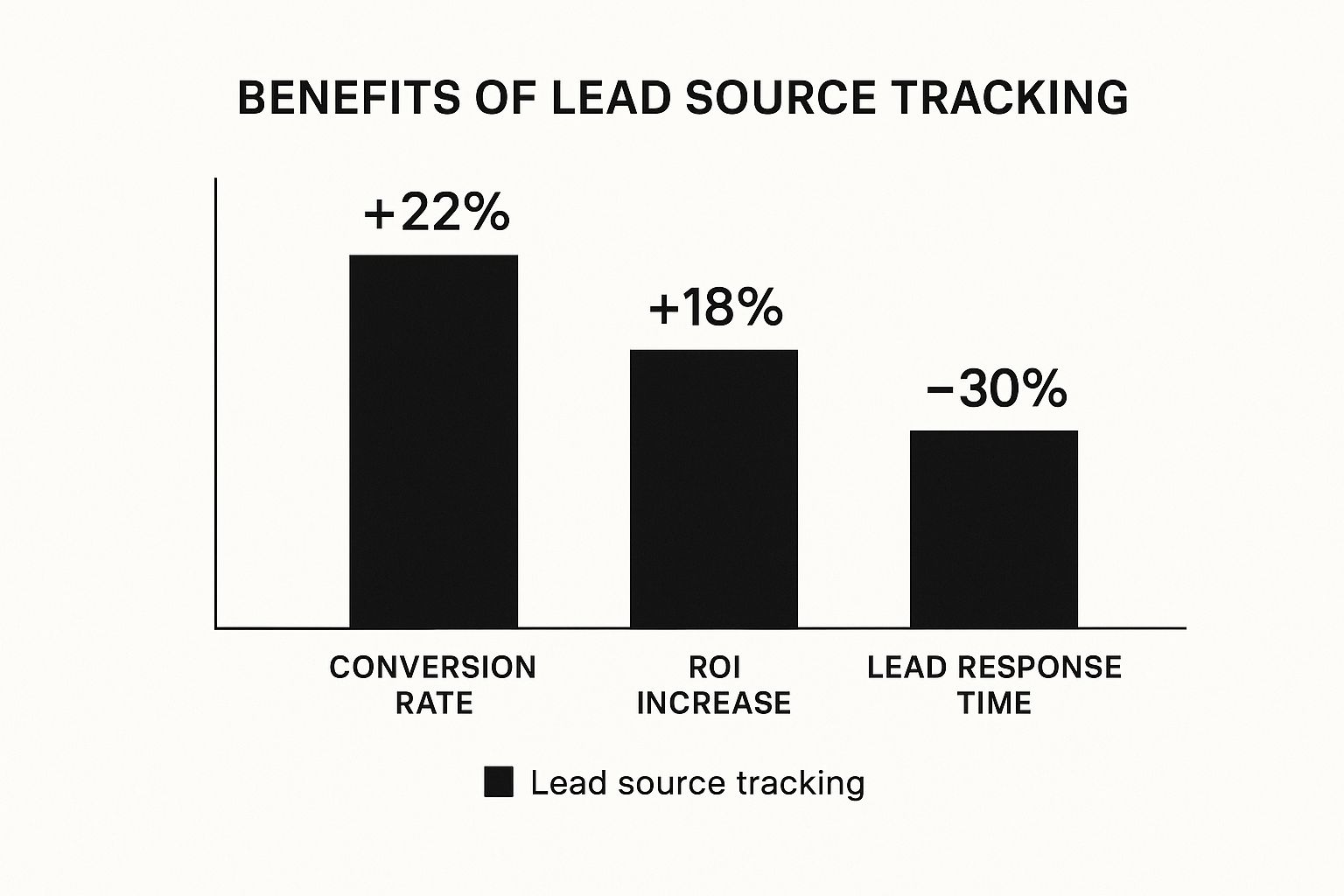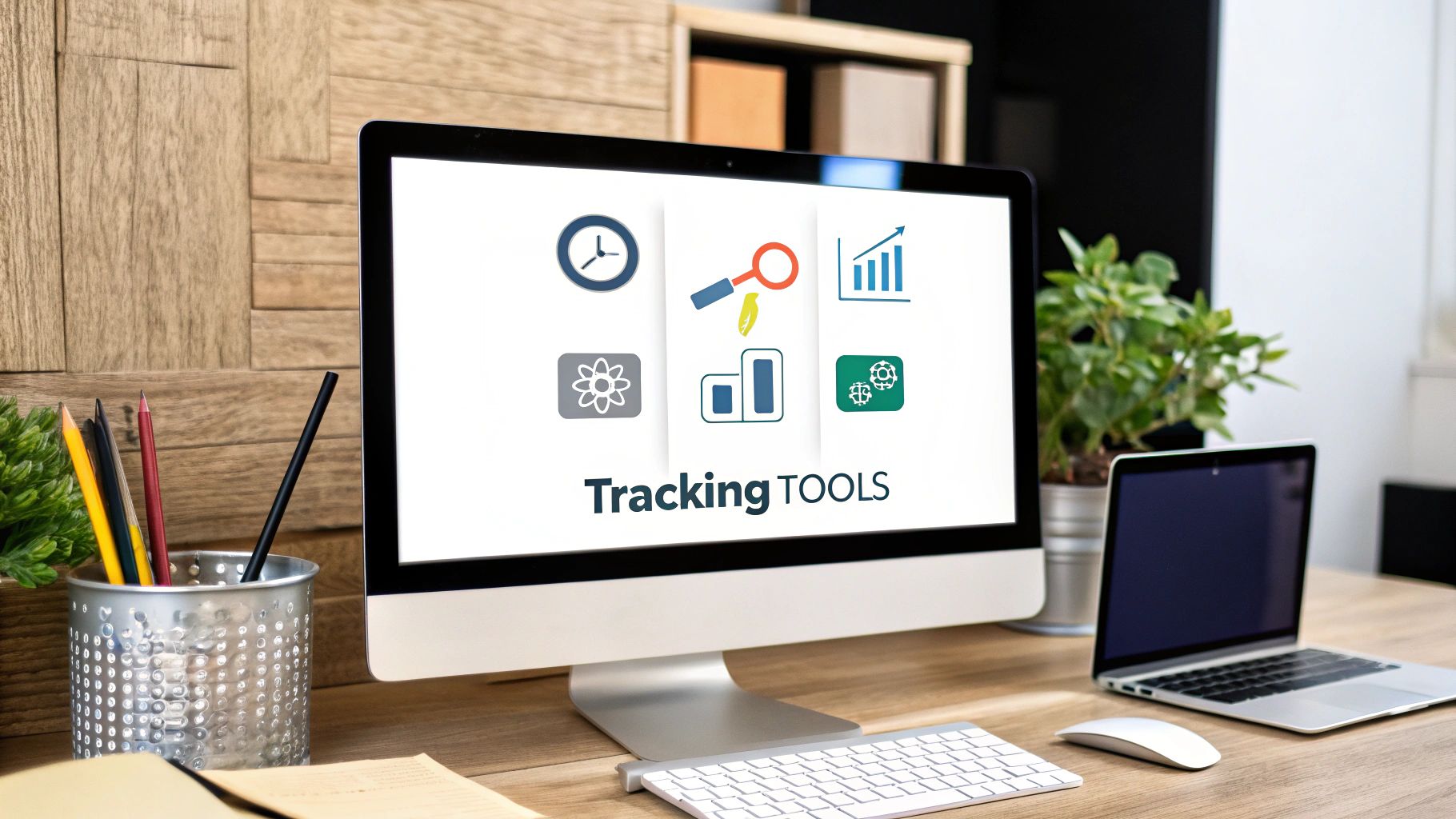Lead Source Tracking: Boost Your Marketing ROI
Lead Source Tracking: Boost Your Marketing ROI
The Power of Knowing Where Your Best Leads Come From

Understanding where your best leads originate is crucial for maximizing your marketing ROI. It's not about superficial metrics like website traffic; it's about linking specific marketing activities to real revenue results. Effective lead source tracking lets you make informed decisions, directing your budget towards channels that genuinely deliver.
Imagine two marketing campaigns: one generates 1,000 website visits, the other only 500. The first looks better, right? But what if the second campaign produces ten qualified leads that convert to paying customers, while the first only yields two? This highlights the importance of lead source tracking.
Why Lead Source Tracking Matters
Lead source tracking allows you to pinpoint the most effective channels, understand customer behavior, and refine your marketing approach. It goes beyond simple traffic analysis by connecting specific campaigns to revenue. This allows you to confidently increase investment in high-performing channels and reduce spending on underperforming ones.
Tracking also reveals hidden patterns. You might discover a particular social media campaign is generating more qualified leads than expected, or a seemingly minor blog post consistently attracts high-value prospects. This insight lets you capitalize on what works and adjust less effective campaigns.
Lead generation strategies rely on various tracking tools for lead optimization. In fact, 78.5% of companies use Google Analytics for website lead tracking, often integrating it with other tools like CRM software and specialized platforms for a complete view of the lead generation process. Find more detailed statistics here This integration allows for more accurate data analysis and improved decision-making.
From Guesswork to Data-Driven Decisions
By accurately tracking lead sources, businesses can shift their marketing from guesswork to a data-driven approach. This leads to improved customer acquisition efficiency and a higher return on investment (ROI). Instead of relying on intuition, your decisions are based on concrete data, providing a clear competitive advantage. You might be interested in learning more about multi-touch attribution: How to master multi-touch attribution
Understanding your lead sources allows you to tailor your messaging and offers to specific audiences. Knowing where your leads originate allows you to create targeted campaigns that resonate with their needs and interests, boosting conversion rates. This precise targeting can make the difference between a successful campaign and a wasted budget. Lead source tracking gives you the knowledge, not just a hunch, of where your best leads are coming from, enabling smarter decisions and optimized marketing for maximum impact.
Building Your Lead Tracking Tech Stack That Actually Works
Having the right tools is essential for effective lead source tracking. This means creating a tech stack that accurately captures lead data from all your channels, both online and offline. Just like a carpenter needs the right tools, marketers need a reliable system to track leads from first contact to final conversion.
Essential Components of a Lead Tracking System
Several tools can be the foundation of a strong lead tracking tech stack:
- CRM (Customer Relationship Management) System: Your CRM is the central hub for all your lead information. Select a CRM that lets you customize fields for tracking sources and integrates smoothly with your other marketing tools. Think of it as the central nervous system for your marketing operations, organizing and managing your leads, monitoring their journey, and analyzing their behavior.
- Marketing Automation Platform: These platforms simplify marketing processes and track lead engagement across channels, from email marketing to social media. Features like automated emails and lead scoring help nurture leads and pinpoint those most likely to convert.
- Website Analytics Tools: Tools like Google Analytics go beyond basic traffic data. They provide valuable insights into how users behave on your website, which helps you understand how leads interact with your content and which pages are most effective for conversions. Understanding where your leads originate is crucial, and you can even find leads through social listening.
- Call Tracking Software: If your sales process involves phone calls, call tracking software is a must. It connects phone leads to specific marketing campaigns, giving you a complete picture of attribution for offline conversions.
- UTM (Urchin Tracking Module) Parameters: These short codes, added to your URLs, track the source, medium, and campaign of your website traffic. They give detailed data on which specific links are driving your conversions.
Visualizing the Impact of Effective Tracking
The right tools lead to measurable improvements in your marketing performance. The infographic below illustrates the benefits businesses see when using effective lead source tracking:

Effective lead source tracking can deliver a 22% increase in conversion rates, an 18% boost in ROI, and a 30% reduction in lead response time. These results demonstrate the power of knowing where your leads are coming from and how they interact with your marketing. This increased efficiency streamlines your sales process and ultimately leads to increased revenue.
Choosing the Right Tools for Your Needs
The best tech stack for you depends on your unique business model and the complexity of your marketing. Free tools like Google Analytics can provide valuable basic data. However, investing in premium solutions often provides advanced features and more detailed insights. This investment can give you a more accurate and comprehensive understanding of your lead sources.
To help you evaluate some options, here's a comparison of popular lead tracking tools:
Lead Source Tracking Tools Comparison: This table compares key features, pricing, and use cases for popular lead tracking tools.
| Tool | Core Features | Best For | Price Range | Integration Capabilities |
|---|---|---|---|---|
| HubSpot | CRM, Marketing Automation, Sales, Service | Small to Enterprise Businesses | Free - $3,200+/month | Wide range of integrations |
| Salesforce | CRM, Sales Cloud, Marketing Cloud, Service Cloud | Medium to Enterprise Businesses | $25 - $300+/user/month | Extensive integration options |
| Marketo | Marketing Automation, Lead Management, Email Marketing | Medium to Enterprise Businesses | $899 - $3,175+/month | Adobe Experience Cloud and other platforms |
| Google Analytics | Website Analytics, Traffic Analysis, Conversion Tracking | All Businesses | Free | Google products and limited third-party tools |
| CallRail | Call Tracking, Call Recording, Conversion Intelligence | Businesses relying on phone calls | $45 - $145+/month | CRM and marketing platforms |
This table highlights key differences and similarities between several popular lead tracking options. Each tool offers a unique set of features and pricing, so it's important to select the one that best fits your specific needs and budget.
A small business might start with a basic CRM and free website analytics. As the business expands, adding a marketing automation platform to manage more complex campaigns might be beneficial. Similarly, businesses that rely heavily on phone calls would likely find call tracking software essential. The key is to build a system that aligns with your specific needs and allows you to accurately track and analyze your lead sources.
Implementing Lead Source Tracking That Actually Works

We've talked about what lead source tracking is, so now let's explore how to do it. Setting up a successful tracking system takes a structured approach and consistent effort. This involves establishing clear processes and selecting the right tools for capturing and analyzing your lead source data. Think of it as building a house: a strong foundation is essential.
Establishing a Consistent Tracking System
Consistency is key for effective lead source tracking. Start by defining naming conventions for your lead sources. For instance, "Organic Social - Facebook" is better than just "Facebook" because it gives you more specific data. Also, create clear protocols for your team to follow when inputting lead source information into your CRM. This maintains data integrity and prevents inconsistencies, especially with multiple team members involved.
Choosing the right tools is also important. Your CRM plays a central role and needs to work smoothly with other tools in your marketing technology stack, such as your marketing automation platform and website analytics. This allows for automated data capture and minimizes manual entry, reducing potential errors. For more integration tips, check out our guide on how to track leads with any form builder.
Tracking Across Different Channels
Lead source tracking isn't just for online channels. Offline sources are important, too. Consider using dedicated phone numbers for different campaigns or setting up a referral tracking system. This provides a comprehensive view of your lead generation and accurately attributes revenue. For example, you might discover that referrals are a major source of high-value leads, encouraging you to invest more in referral programs. Integrating AI systems allows for real-time tracking with AI Receptionists and Real-Time Lead Tracking.
Businesses generate an average of 1,877 leads per month, with 81% typically being marketing-qualified leads (MQLs). The average cost per lead is about $198.44 across industries. Explore this topic further. This emphasizes the importance of not just generating leads, but also understanding their quality and source to optimize your budget.
Handling Multi-Touch Attribution
Customer journeys are often complex and involve multiple touchpoints. Multi-touch attribution models help analyze these interactions and assign credit across the conversion path. However, these models can get complicated. Start simple with a first-touch or last-touch model, and gradually incorporate more advanced models as needed. This approach avoids overcomplicating your analysis while still providing valuable customer journey insights, enabling you to optimize each touchpoint and improve conversion rates at every stage. Remember, the goal is understanding, not complex data.
Turning Raw Lead Data Into Revenue-Driving Insights

Implementing a robust lead source tracking system is only the first step. The real power comes from turning that raw data into actionable insights that boost revenue. This means understanding not just where your leads originate, but why some channels perform better than others.
Visualizing Your Lead Source Data
Making sense of complex lead source information relies on effective data visualization. Clear visuals like charts and graphs make it easier for everyone, from executives to campaign managers, to grasp the data's meaning. A pie chart, for example, can quickly show the percentage of leads from each source, while a line graph can reveal trends over time. This shared understanding promotes better decision-making and teamwork.
Key Metrics for Lead Source Tracking
Several key metrics can help you measure the effectiveness of your lead source tracking and shape your marketing strategies. Let's explore some of the most important ones.
To help you get a better overview, we’ve compiled the essential metrics into a handy table:
Essential Lead Source Tracking Metrics Overview of the most important metrics to monitor when tracking lead sources
| Metric | Definition | Calculation Method | Benchmark Range | Improvement Strategies |
|---|---|---|---|---|
| Cost Per Lead (CPL) | The cost of acquiring a single lead from a specific source. | Total marketing spend for a source / Number of leads generated from that source | Varies widely by industry and channel | Refine targeting, optimize ad copy, test different channels |
| Conversion Rate | The percentage of leads from a source that convert into paying customers. | (Number of conversions from a source / Number of leads from that source) * 100% | Industry-specific, aim for continuous improvement | Improve landing page experience, personalize messaging, offer promotions |
| Lead Quality | An assessment of lead engagement and potential, often measured by lead score and customer lifetime value (CLTV) | Lead scoring models, CLTV calculations | Higher scores and CLTV indicate better quality | Content marketing, targeted lead nurturing campaigns |
| Return on Investment (ROI) | The overall return from your investment in a particular lead source | (Revenue generated from a source - Cost of the source) / Cost of the source | Positive ROI is the goal | Focus on high-performing channels, optimize spending, track results diligently |
This table summarizes the core metrics you should be tracking and provides actionable strategies to enhance each one. Focusing on these will give you a more complete picture of your lead generation efforts.
From Insights to Action: Optimizing Your Marketing Strategy
By analyzing these metrics, you can spot new channel opportunities, recognize warning signs of declining performance, and adapt to seasonal patterns. For example, a sudden drop in leads from a specific social media platform warrants investigation and corrective action. Understanding seasonal trends helps you anticipate changes in lead volume and adjust your budget accordingly.
This data-driven approach allows you to optimize your marketing campaigns for maximum ROI. You can shift budgets based on actual source performance, refine your messaging based on lead quality insights, and test new strategies to continually improve channel effectiveness. This constant optimization sets successful marketing teams apart. By turning raw lead data into revenue-driving insights, you can make informed decisions that drive sustainable growth. Learn more about maximizing your marketing ROI here: Marketing ROI Measurement.
Maximizing Marketing ROI Through Source Intelligence
Understanding where your leads come from is essential for maximizing your marketing ROI. It's not enough to just track website visits or social media followers. You need lead source intelligence. This means understanding which marketing activities are actually driving business results. With this knowledge, successful marketing teams can move beyond guesswork and allocate their budgets strategically.
Let's look at an example. Imagine two campaigns. One has high social media engagement, but few conversions. The other has lower engagement but significantly more sales. Lead source tracking reveals the true value of each. This allows you to invest more in what drives revenue, regardless of less meaningful metrics. Focusing on results like this allows businesses to dramatically improve marketing returns, while competitors remain unsure about what truly works.
Transforming Insights Into Strategic Advantages
This data-driven approach involves reallocating budgets based on true source performance, not just assumptions. It's about using data insights to prioritize the channels that bring in the most qualified leads. Successful marketing leaders are constantly testing and refining their approach based on this source intelligence. For further reading, check out this helpful article: How to master marketing ROI measurement.
This isn't just a theory. Businesses using lead source tracking see real improvements in their customer acquisition costs (CAC). In many cases, they are achieving 2-5X improvements simply by optimizing based on accurate lead source data. This involves identifying high-performing channels, refining their messaging, and ultimately driving down the cost of acquiring each new customer.
Scaling Success and Cutting Losses
Lead source intelligence also helps businesses scale their most effective channels without seeing diminishing returns. It provides the insights needed to understand how to grow successful campaigns efficiently. It also highlights underperforming tactics that might be worth saving. Through careful analysis, you can pinpoint campaigns with potential and make adjustments to improve their performance.
Lead source tracking also shows you when to cut your losses. If the data consistently shows a campaign isn't generating qualified leads, it's a clear sign to redirect your resources. This prevents wasted marketing budget on ineffective tactics. The global market for lead generation has grown significantly in recent years. It's projected to reach $15.55 billion by 2031, at a CAGR of 17.5%. This growth brings increased competition, emphasizing the importance of strategic lead generation. Learn more about lead generation statistics. This rapid growth makes it even more critical to optimize your strategies and invest wisely. This data-driven approach empowers businesses to make informed decisions, maximizing their marketing ROI and gaining a competitive edge.
Overcoming Lead Tracking Challenges That Derail Success
Lead source tracking is essential, but it comes with its own set of difficulties. Even with robust systems in place, challenges can pop up and impact the accuracy of your data. This can make it harder to get the most out of your marketing ROI. Addressing these challenges directly is critical for long-term success.
Tackling Cross-Device Attribution
Today's customer journey often involves multiple devices. Someone might see your brand first on their phone via a social media ad, and then later visit your website on their laptop to buy something. Tracking this conversion accurately gets tricky, as traditional methods struggle to connect those interactions. Cross-device tracking, which uses login data or probabilistic modeling, can help to connect the dots and create a more complete view of the customer's experience.
Maintaining Tracking Integrity With Ad Blockers
The growing use of ad blockers presents a real challenge for lead source tracking. Ad blockers can stop tracking pixels and scripts from working, leading to incomplete data and inaccurate attribution. Implementing server-side tracking and exploring other methods, like fingerprint tracking, can help reduce the impact of ad blockers and maintain accurate data. This way, you still capture valuable lead information.
Connecting Offline Conversions to Digital Origins
Connecting offline and online activity is essential for a full understanding of lead attribution. For example, a customer might see your online ad and then call your sales team to make a purchase. Connecting this offline conversion back to the initial online ad requires strategies like call tracking with dedicated phone numbers or unique coupon codes for offline promotions. This ties offline actions to digital campaigns, giving you valuable insights into online-to-offline customer journeys.
Unmasking the Mystery of "Direct Traffic"
Direct traffic often shows up in analytics reports as a general category for traffic sources that are hard to identify. But, this seemingly simple category can hide useful lead source data. Direct traffic could include visitors who clicked a link in an untagged email, typed your URL directly after seeing an offline ad, or bookmarked your site after finding you through a paid search campaign. Using detailed UTM tagging, analyzing user behavior, and using campaign-specific landing pages can reveal the true sources within direct traffic. This helps you find hidden opportunities and understand your marketing performance more accurately.
Navigating Extended Sales Cycles and Multi-Touch Attribution
For businesses with longer sales cycles, many interactions often influence the final purchase. Understanding how much each touchpoint contributes to the sale requires using multi-touch attribution models. But, complex models can be hard to manage and understand. Starting with simple models like first-touch or last-touch attribution and then slowly adding more complex ones like linear or time-decay attribution can offer helpful insights without overcomplicating your analysis. This helps you better understand the complex customer journey and improve your marketing strategy.
Future-Proofing Your Lead Source Tracking Strategy
The marketing world is ever-evolving, and lead tracking is no exception. Is your current lead source tracking system ready for what's next? Forward-thinking businesses are adapting to emerging trends to stay ahead.
Navigating The Shifting Sands Of Privacy
Regulations like GDPR and CCPA are changing how we collect and use data. Smart companies are prioritizing user privacy while maintaining effective lead tracking. They're finding innovative strategies to comply with these rules without sacrificing valuable marketing performance insights.
Embracing The Power Of First-Party Data
With the decline of third-party cookies, first-party data strategies are now essential. Collecting data directly from your audience through your website, email list, and other owned channels provides more accurate and reliable information about your leads. This gives you a clearer understanding of your customer base.
Harnessing The Potential Of AI-Powered Attribution
AI-powered attribution models enhance multi-touch analysis. By analyzing complex customer journeys, these models provide a more precise understanding of which touchpoints drive conversions. This allows for campaign optimization and maximizes impact. This technology is no longer a futuristic concept; it's a practical tool for today's marketers.
Leveraging Intent Data For Smarter Lead Qualification
Understanding your leads' intent—what they're actively searching for—is revolutionizing lead qualification. Intent data helps identify high-value prospects early in the sales funnel. This allows you to focus efforts on those most likely to convert.
Gaining A Competitive Edge With Predictive Analytics
Predictive analytics plays a growing role in identifying high-potential prospects. By analyzing past customer behavior and other data, predictive analytics can reveal patterns and predict which leads are most likely to convert into paying customers. This provides a competitive edge, allowing you to focus on the most promising opportunities.
By adapting to these trends, you can ensure your lead source tracking remains effective and provides the data necessary for marketing optimization and revenue growth. Stay ahead of the curve and ensure your tracking system is future-ready.
Ready to take control of your lead source tracking and boost your marketing ROI? LeadPulse helps you understand where your leads and customers originate, giving you the insights to optimize your campaigns. Learn more and sign up for a free trial today.